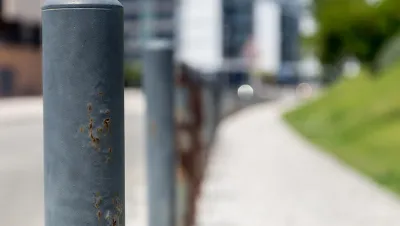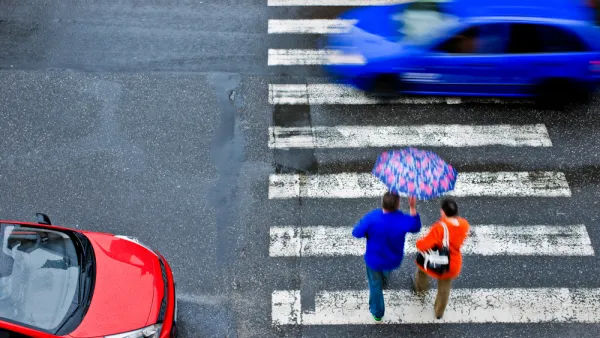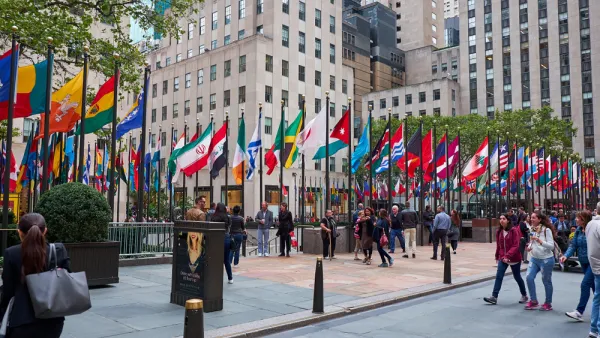Countless lives were likely saved by a strategically placed bollard on W. 45th Ave. which stopped a motorist who had driven three blocks on city sidewalks, mowing-down as many pedestrians as possible, from entering the Times Square pedestrian plaza.

On May 18, Bronx resident Richard Rojas, a 26-year-old Navy veteran high on PCP, made a sudden U-turn on Seventh Avenue and W. 42nd St., driving onto the sidewalk and where he proceeded unimpeded to strike 23 pedestrians on three blocks of the Seventh Avenue sidewalk. One of them, Alyssa Elsman, 18, who was visiting New York City from Michigan, died of her injuries.
Although the incident was determined not to be the act of a terrorist, it was the threat of terrorism that was responsible for the bollards being placed at the entrance to the pedestrian plaza, recounts Benjamin Mueller for The New York Times.
Planners describe it as a turning point in the redesign of Times Square: a meeting around the end of 2012 when David C. Kelly, then the Police Department’s assistant commissioner for counterterrorism, showed up with a copy of Al Qaeda’s English-language magazine, which called on attackers to "mow down” pedestrians with pickup trucks.
Soon, at Mr. Kelly’s recommendation, pedestrian plazas that had replaced roadway along a five-block stretch of Broadway were guarded by three-foot-tall, stainless-steel cylindrical bollards.
In an op-ed published in the Daily News (posted here) on the Times Square rampage, Paul Steely White, executive director of New York City-based Transportation Alternatives, wrote:
To prevent further loss of life, in the wake of yesterday’s tragedy we must realize that it was the controversial street safety improvements applied to Times Square in recent years — including wider sidewalks protected with steel and concrete bollards — that prevented the tragedy from being far worse.
Burney describes the planning process that was responsible for the installation of the bollards, and why more weren't placed around the area during the redesign that officially opened April 19 after work first began in May 2009.
“We found the right balance between the type of potential threat and the idea of creating a porous and fluid public realm,” said Craig Dykers, founding partner of Snøhetta, the architectural firm on the project,
While the threat from terrorists is real, as was tragically shown in Nice, France at a Bastille Day celebration last year when a terrorist drove a truck into a crowd, killing 85 and injuring over 200, so too is the threat from motorists like Rojas, who has a criminal record and a history of drunken driving and mental illness.
More bollards recommended
"The city is considering adding bollards on sidewalks around Times Square to match those around pedestrian plazas, the Police Department’s deputy commissioner for intelligence and counterterrorism, John J. Miller, told the City Council on [May 23]," adds Mueller.
Ydanis Rodriguez, a city councilman who is the chairman of the transportation committee, said he began drafting legislation several months ago to ask that bollards be installed outside schools and on busy corners across the city.
"We can and should do more to keep our residents and visitors safe on our streets and street design is the first place to start," said Rodriguez,
"It is likely that the next pedestrian death will not occur under the worldwide lens of Times Square, but on a regular street in a regular New York City neighborhood," adds White.
FULL STORY: In Times Square Attack, Bollards Stopped One Car. But What About the Next?

National Parks Layoffs Will Cause Communities to Lose Billions
Thousands of essential park workers were laid off this week, just before the busy spring break season.

Retro-silient?: America’s First “Eco-burb,” The Woodlands Turns 50
A master-planned community north of Houston offers lessons on green infrastructure and resilient design, but falls short of its founder’s lofty affordability and walkability goals.

Delivering for America Plan Will Downgrade Mail Service in at Least 49.5 Percent of Zip Codes
Republican and Democrat lawmakers criticize the plan for its disproportionate negative impact on rural communities.

Test News Post 1
This is a summary

Test News Headline 46
Test for the image on the front page.

Balancing Bombs and Butterflies: How the National Guard Protects a Rare Species
The National Guard at Fort Indiantown Gap uses GIS technology and land management strategies to balance military training with conservation efforts, ensuring the survival of the rare eastern regal fritillary butterfly.
Urban Design for Planners 1: Software Tools
This six-course series explores essential urban design concepts using open source software and equips planners with the tools they need to participate fully in the urban design process.
Planning for Universal Design
Learn the tools for implementing Universal Design in planning regulations.
EMC Planning Group, Inc.
Planetizen
Planetizen
Mpact (formerly Rail~Volution)
Great Falls Development Authority, Inc.
HUDs Office of Policy Development and Research
NYU Wagner Graduate School of Public Service




























